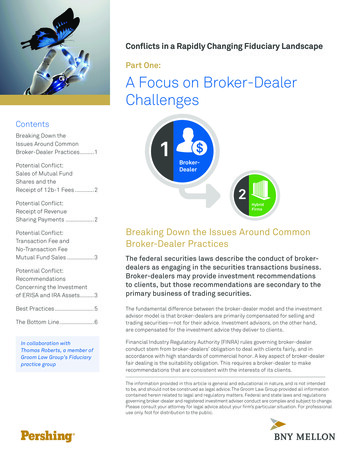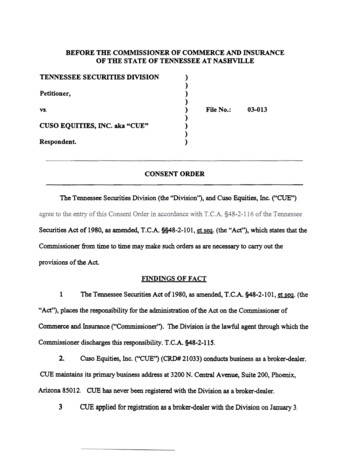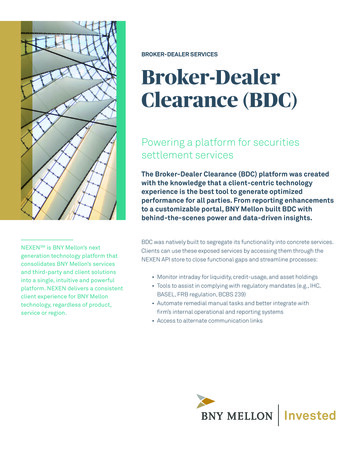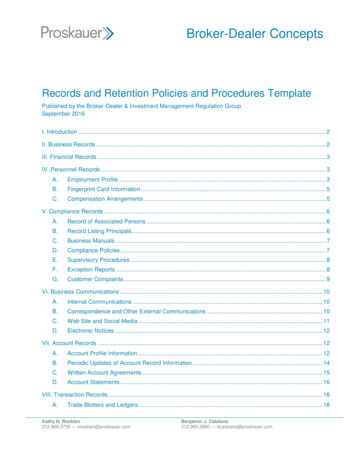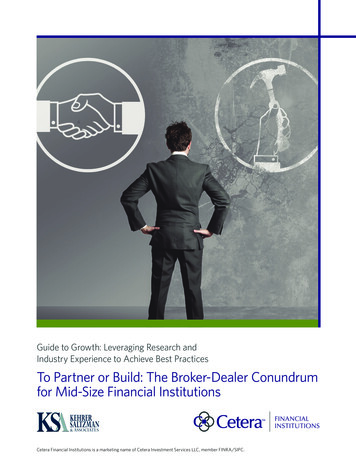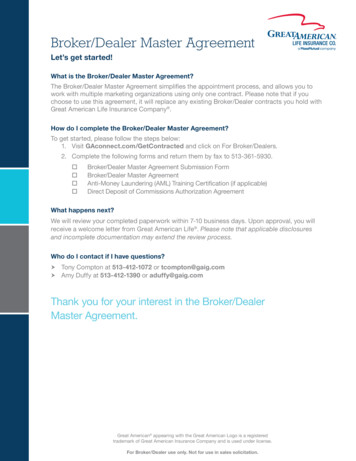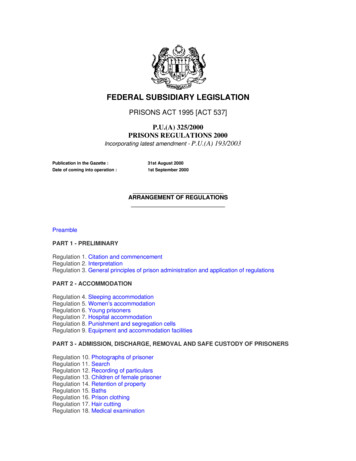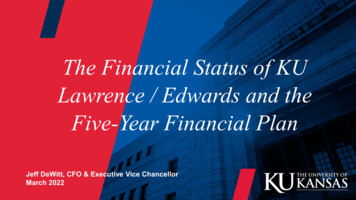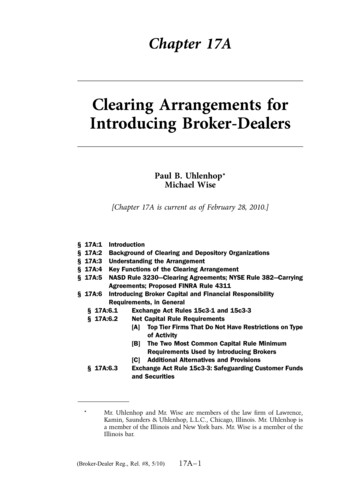
Transcription
Chapter 17AClearing Arrangements forIntroducing Broker-DealersPaul B. Uhlenhop*Michael Wise[Chapter 17A is current as of February 28, ionBackground of Clearing and Depository OrganizationsUnderstanding the ArrangementKey Functions of the Clearing ArrangementNASD Rule 3230—Clearing Agreements; NYSE Rule 382—CarryingAgreements; Proposed FINRA Rule 4311§ 17A:6 Introducing Broker Capital and Financial ResponsibilityRequirements, in General§ 17A:6.1Exchange Act Rules 15c3-1 and 15c3-3§ 17A:6.2Net Capital Rule Requirements[A] Top Tier Firms That Do Not Have Restrictions on Typeof Activity[B] The Two Most Common Capital Rule MinimumRequirements Used by Introducing Brokers[C] Additional Alternatives and Provisions§ 17A:6.3Exchange Act Rule 15c3-3: Safeguarding Customer Fundsand Securities*Mr. Uhlenhop and Mr. Wise are members of the law firm of Lawrence,Kamin, Saunders & Uhlenhop, L.L.C., Chicago, Illinois. Mr. Uhlenhop isa member of the Illinois and New York bars. Mr. Wise is a member of theIllinois bar.(Broker-Dealer Reg., Rel. #8, 5/10)17A–1
BROKER-DEALER REGULATION[A]§§§§§§§§§§Mutual Fund, Separate Account and S&L SolicitationExemption[B] Special Account Introducing Brokers[C] Introducing Brokers§ 17A:6.4Summary17A:7 Proprietary Assets Held by Clearing Firm17A:8 Clearing Deposits17A:9 Check Writing and Local Cashiering17A:10 Risk Management and ACT17A:11 AML and OFAC Issues17A:12 Fair and Accurate Credit Transactions Act of 2003 and PrivacyRequirements17A:13 Introducing Broker Best Execution17A:14 Piggybacking Arrangements17A:15 Prime Brokerage Arrangements§ 17A:15.1 Introduction§ 17A:15.2 Background§ 17A:15.3 Execution of the Prime Brokerage Agreements§ 17A:15.4 Lack of Appropriate Customer Documentation§ 17A:15.5 Customer Credit and Suitability Obligations§ 17A:15.6 Executing Broker Risk Control§ 17A:15.7 Clearing (Prime) Broker Risk Control§ 17A:15.8 Extension of Credit on Syndicated and Other PublicOfferings17A:16 Considerations in Negotiating a Clearing Arrangement§ 17A:16.1 Business Activities§ 17A:16.2 The Amount of Clearing Deposit§ 17A:16.3 ACT Credit Line§ 17A:16.4 Cost of Clearing§ 17A:16.5 PAIB§ 17A:16.6 Financial Reports and Financial Information§ 17A:16.7 Registration§ 17A:16.8 Customer Accounts§ 17A:16.9 Acceptance of Accounts and Sales Practice Obligations§ 17A:16.10 Compliance Procedures and Exception Reports§ 17A:16.11 Margin and Extension of Credit§ 17A:16.12 Maintenance of Books, Records and Reports§ 17A:16.13 Reports by the Introducing Firm to the Clearing Firm§ 17A:16.14 Customer Funds and Securities§ 17A:16.15 Local Deposit of Funds and Drafting Authority§ 17A:16.16 Confirmations and Account Statements§ 17A:16.17 Execution of Orders and Transactions§ 17A:16.18 Commissions and Fees§ 17A:16.19 Return of Clearing Firm Deposit§ 17A:16.20 Indemnification§ 17A:16.21 Exclusive Services§ 17A:16.22 Proprietary Trading, Underwriting, Market Making andSpecialist Activities17A–2
Clearing Arrangements for Introducing Broker-Dealers§§§§§§§§ 17A:16.2817A:16.29Disciplinary Action, Regulatory Forms and NoticesUse of Clearing Firm’s NameExcess SIPC CoverageTerminationConfidentiality and Non-Solicitation ProvisionsArbitrationAnti-Money Laundering, OFAC and Fact Act CoordinationProvisions§ 17A:17 Negative Consent Letters and Bulk Account Transfers§ 17A:18 Third-Party Liability of Clearing Firm and Introducing Brokers§ 17A:1IntroductionThis chapter highlights key business and regulatory issues relevantto the clearing arrangement between an introducing broker-dealer(“introducing broker”) and a clearing broker-dealer (“clearing firm”).We do not intend to detail clearing firm operations or regulation,clearing agency membership, or securities clearance and settlement,except as relevant to introducing broker-dealers.1The National Association of Securities Dealers, Inc. (NASD), haschanged its name to the Financial Investment National RegulatoryAgency (FINRA). FINRA has also assumed responsibility for certainregulatory functions of the New York Stock Exchange (NYSE). At thepresent time, FINRA is combining the former NASD rulebook withthe NYSE rules with the goal of having a consolidated rulebook, whichproject should be completed in the next year. At this time, there aresome NYSE regulatory rules that have been integrated and consolidated with former NASD rules and are referred to herein as FINRArules. In other cases, particularly with respect to NASD Rule 3230 andNYSE rule 382 dealing with clearing arrangements, the rules have notbeen consolidated. Where a NYSE rule has not been consolidated, itwill be referred to as NYSE rule. All other former NASD rules andcurrently consolidated rules will be referred to as FINRA rules. 2Transitional Rulebook. Former NASD Notices to Members will continue to be referred to as NASD NTM or NTM. FINRA Notices will bereferred to as Regulatory Notices.1.2.For a detailed legal and business discussion of the clearing arrangement,see Henry Minnerop’s definitive legal work, Henry Minnerop, ClearingArrangements, 58 BUS. LAW. 917 (May 2003) [hereinafter Minnerop].See FINRA, Rule Conversion Chart, available at 60.(Broker-Dealer Reg., Rel. #8, 5/10)17A–3
§ 17A:2BROKER-DEALER REGULATION§ 17A:2Background of Clearing and DepositoryOrganizationsFor many years, a broker-dealer settled a securities transactiondirectly with the counter broker-dealer. For example, if broker-dealer Xbought Ford Motor Company common stock for a customer bypurchasing from broker-dealer Y, X would settle the transaction directlywith Y. A confirmation would be generated by each broker-dealerconfirming the trade as known to that broker-dealer. X also wouldconfirm the purchase to its customer, and Y would confirm the sale toits customer.If the trade was confirmed by both broker-dealers, the trade wouldbe settled by X having a messenger take a check to Y’s back office,which surrendered to X a stock certificate with blank stock power. Xwould then hold the security certificate for its customer or have thecertificate transferred into the customer ’s name and facilitate deliveryto the customer. If the confirmations between broker-dealers did notmatch, an out trade would occur. If the transactions did not settlewithin the required time, there was a default or failure and thetransaction would not close until the securities were delivered.By the late 1950s and early 1960s, large broker-dealers attempted toimprove this process by settling on a net basis once a day. In such case,X would aggregate all transactions with Y as a counterparty, determinethe total net amount bought and sold in a security, and the net amountto be received or paid for all securities. For example, if X’s customersbought 500 shares, and sold 300 shares, of Ford Motor Company withY as the contra broker, Y would be obligated to deliver 200 net shares toX. Likewise, the total amount to be received or paid from all transactions with a specific counter broker-dealer during the day would benetted. However, this procedure limited clearance and settlement onlybetween two broker-dealers, and still involved the movement of moneyand delivery of physical securities certificates between broker-dealers.Exchange and over-the-counter trading increased enormously duringthe 1960s, and by the early 1970s, the financial community experienceda “paper crunch” because of the high volume of transactions. Theindustry, with the SEC’s prodding, established clearing operations fornet clearance and settlement.3 Each exchange generally established itsown clearing agency to provide net clearance and settlement.In the clearance process, the clearing agency compares tradessubmitted by its broker-dealer “members” or “participants.” Theclearing agency matches the submitted trades, and verifies that theywill “clear,” that is, the trades submitted by each side are consistent.3.See generally Exchange Act § 17A; 15 U.S.C. § 78(Q)-1 et seq.17A–4
Clearing Arrangements for Introducing Broker-Dealers§ 17A:2In the settlement process, cleared trades are “settled” by movement ofsecurities positions, or corresponding transfers of money.Depository trust companies hold in safekeeping and custody certificates for securities. Depositories hold all of a member ’s or participant’s securities certificates for customers and proprietary positions,thereby immobilizing securities certificates and facilitating transfer bybook entry. If a participant had 10,000 shares of Ford Motor Companyin its depository trust account and its customers sold 5,000 shares andbought 3,000 shares, the net amount of 2,000 shares could betransferred by book entry to the participant whose customers areowed the securities.By using clearing corporations and depositories to clear and settleonce a day, the net amount could be compared, and then settled bywire transfer of funds due on a net basis. Likewise, securities would benetted and transferred largely by book entry. Over time, interfacesbetween clearing corporations and the depositories developed to enablea member of one clearing agency to settle its trades with a brokerdealer that was a member of another clearing agency. The SECregulates these clearing corporations and depositories.More recently, smaller clearing corporations and depositorieswere terminated or merged, resulting today in the Depository Trust &Clearing Corporation (DTCC). DTCC is a holding company thatowns the National Securities Clearing Corporation (NSCC), theDepository Trust Company (DTC), the Fixed Income Clearing Corporation and other affiliates, and provides net clearance and settlementservices to participant broker-dealers—the clearing firms. NSCCperforms net clearing and other services. DTCC provides custodyand safekeeping, holding certificates or other indication of ownershipto facilitate book-entry transfer.4The Fixed Income Clearing Corporation provides real-time tradematching and clearing and settlement services for government, municipal and fixed income securities. The services of the Fixed IncomeClearing Corporation also include pool notification, net settlementservice and repurchase agreement services.DTC also provides DTC LOAN/SERV, which reconciles lenderpositions daily between agents and lenders around the world.DTCC Deriv/SERV LLC is a wholly-owned subsidiary of DTCC,and provides automated matching and confirmation services forover-the-counter derivatives, including credit, equity, and interest4.DTCC offers other services, such as a reorganization service, directregistration system, dividend services, legal notification service, proxyservice and restricted securities services. For example, the reorganizationservice provides participants with information about corporate reorganizations such as a merger or bankruptcy.(Broker-Dealer Reg., Rel. #8, 5/10)17A–5
§ 17A:3BROKER-DEALER REGULATIONrate derivatives. It also provides certain other services, includingmatching of payment flows and bi-lateral netting services. EuropeanCentral Counterparty Limited is also a DTCC subsidiary that providesautomation, centralization, standardization, and streamline process inthe European market for certain firms.5When secondary options trading was introduced by the ChicagoBoard of Exchange (CBOE), the Options Clearing Corporation (OCC)was formed to issue and clear options. The OCC clears all optionslisted on U.S. options markets, and also clears security futures andinterfaces with other clearing houses.Because of the globalization of the financial service business, mostoffshore markets include clearing corporations and depositories.Offshore clearing agencies offer substantially the same services asDTCC, OCC and the futures clearing houses provide in the UnitedStates. Many large domestic clearing firms also are direct or indirectmembers of foreign clearing agencies, because of the number ofinternational transactions in securities and futures effected in foreignmarkets.Most broker-dealers are not members of a clearing corporation or adepository. Only clearing firms, who can meet the membershiprequirements of substantial assets, liquidity, and capital, are permittedto be clearing agency participants. These clearing firms also mustmaintain a large back office of expert employees and state of the artinformation facilities, since most communications between a participant and a clearing agency are by electronic communication. Inaddition, substantial banking relationships are required for regularmovement of money.Because of these infrastructure and capital requirements, the number of clearing agency participants is limited. Broker-dealers who arenot clearing agency participants require access through a clearingfirm. These accessing broker-dealers are called introducing brokers,described in more detail below.§ 17A:3Understanding the ArrangementThere are essentially two types of clearing arrangements, called“fully disclosed” and “omnibus” arrangements. The fully disclosedclearing arrangement is more common. In a fully disclosed arrangement, the introducing broker introduces transactions to a clearing firmthat is a DTCC participant for clearance, settlement and custody.5.The DTCC, through its other subsidiaries, offers certain services inconnection with newly issued securities in connection with underwritings,mutual fund services, certain insurance services, stock borrowing and loanservices and direct settlement services for large institutions.17A–6
Clearing Arrangements for Introducing Broker-Dealers§ 17A:3The arrangement is called fully disclosed because division of thefunctions between the clearing firm and introducing broker isdisclosed to the customers of the introducing broker.In an omnibus arrangement, an omnibus clearing firm carries in asingle account the positions of introduced customer transactions ofthe introducing broker. The introducing broker ’s proprietary positionsalso may be carried, but introducing broker proprietary transactionsare effected in an account separate from customer transactions. Theomnibus clearing firm performs clearance, settlement, execution andcustody pursuant to contract with the introducing broker. In anomnibus arrangement, the introducing broker remains legally responsible for custody, clearing, capital requirements, reserve deposits,books and records as a clearing firm, but the omnibus broker-dealercontractually performs certain of these functions for the introducingbroker.In a fully disclosed arrangement, the introducing broker will generally have significantly lower financial responsibility requirementsunder the SEC capital rule, Rule 15c3-1 under the Securities ExchangeAct of 1934 (“Exchange Act”) and under the SEC financial safekeepingrule, Exchange Act Rule 15c3-3. Although the introducing broker willbe responsible for certain required books and records, the clearing firmwill generate and maintain many of such records for the introducingbroker pursuant to the clearing agreement. The clearing firm alsousually provides excess SIPC insurance.In an omnibus relationship, the introducing broker has a highercapital requirement, must meet the requirements of the SEC safekeeping of customer funds and securities, and must maintain requiredbooks and records. Furthermore, in an omnibus relationship, anyexcess SIPC insurance must be maintained by the introducing broker.One of the advantages of the omnibus arrangement is that, particularly with respect to securities in which the introducing broker doesnot effect many transactions, such as foreign securities, the introducing broker would not need to be a member of foreign clearing agenciesor other foreign organizations. Likewise under the omnibus arrangement for U.S. securities or options, clearance and settlement maysometimes be effected by the omnibus clearing firm without theintroducing broker being a member of a clearing agency such asNSCC or OCC.A facilities management agreement is somewhat similar to anomnibus clearing arrangement. Some broker-dealers that wish to bea clearing firm and have the adequate capital may lack the requisiteback-office infrastructure, personnel, or communications systems.Such broker-dealers may outsource their back-office operations settlement clearing service through a facilities management agreement toanother clearing firm that has such infrastructure and is also a clearing(Broker-Dealer Reg., Rel. #8, 5/10)17A–7
§ 17A:4BROKER-DEALER REGULATIONmember. Some broker-dealers that wish to be clearing members enterinto a facilities management agreement with another clearing member,outsourcing all or part of the back-office clearing and settlement. In anyevent, the clearing member that outsources these functions through afacilities management agreement remains responsible to the regulatorsfor its capital as a clearing member, and for all functions performedunder the facilities management agreement by the clearing firm.The clearing agreement is a classic outsourcing arrangement underwhich certain functions of the correspondent or introducing broker aredelegated to the clearing firm. Clearing agreements must conformwith FINRA Rule 3230, or its counterpart, NYSE Rule 382, asexplained in more detail below.Economics drives the clearing relationship as explained in moredetail below. The fixed cost for clearing and settling transactions ishigh because clearing firms must maintain memberships in clearingagencies, participants’ deposits, experienced personnel and sophisticated systems.Clearing firm start-up costs are substantial and generally cannot beeconomically justified, absent a significant volume of business. Inaddition, regulatory agencies are reluctant to approve a start-up brokerdealer for full service status, since approval is contingent on demonstration of experience, risk control systems and personnel. Until abroker-dealer ’s business involves a significant volume of transactions,the fixed cost for clearing per transaction will be far higher than if thefirm introduces to an established clearing firm for clearance andsettlement. Because of the inherent fixed costs, clearing firms have asignificant advantage if they can attract additional business.§ 17A:4Key Functions of the Clearing ArrangementMr. Henry Minnerop’s definitive article on clearing identifies keyfunctions involved in maintaining, clearing and settling customeraccounts:1.opening, approving, and monitoring customer accounts;2.providing investment recommendations or accepting customerorders;3.executing customer orders;4.extending credit in margin accounts;5.providing written confirmations of executed orders tocustomers;6.receiving or delivering funds or securities from or to customers;17A–8
Clearing Arrangements for Introducing Broker-Dealers§ 17A:47.maintaining books and records that reflect transactions, including rendering monthly or periodic statements of accountto customers;8.providing custody of funds and securities in customeraccounts;9.clearing and settling transactions effected in customer accounts; and10. providing electronic systems for compliance and managementof the introducing broker.6For brokers introducing accounts on a fully disclosed basis, theclearing agreement will divide the above functions between the introducing broker and the clearing firm. In most clearing arrangements, allback-office operations are handled by the clearing firm, and the frontoffice or customer relationships are performed by the introducingbroker. In the omnibus relationship, some of the back-office andexecution functions are performed on a contract basis for the introducing broker but the introducing broker is responsible for all of thosefunctions as if it was performing them itself.NYSE and FINRA rules require that a fully disclosed clearingagreement divide the functions between the firms. Customers mustbe notified in a summary statement of the nature of the division offunctions and which entity will be performing what function. 7 Mostfully disclosed clearing arrangements provide that customer relationfunctions are the responsibility of the introducing broker. The introducing broker generally is responsible for opening, approving andmonitoring customer accounts, providing any recommendations, dealing with customer complaints and problems, accepting customerorders for execution, collecting margin, and compliance matters arising from those areas. Customer orders may be executed by theintroducing broker either through the clearing firm or through somethird-party broker-dealer and given up to the clearing firm for settlement. While margin credit may be extended by the clearing firm to anintroducing broker’s customer, the margin credit is, under almost allclearing agreements, the financial responsibility of the introducingbroker. The introducing broker must indemnify the clearing firm forany margin or credit losses (that is, customer ’s failure to pay).While in most clearing arrangements transaction confirmations areprepared and mailed by the clearing firm, confirmations may be printed6.7.Minnerop, Clearing Arrangements, 58 BUS. LAW. 917, 924, n.28 (May2003).NYSE Rule 382; FINRA Rule 3230. For further details, see infra section17A:5. See FINRA Rule 4311.(Broker-Dealer Reg., Rel. #8, 5/10)17A–9
§ 17A:5BROKER-DEALER REGULATIONand mailed to customers by the introducing broker. Monthly accountstatements are usually prepared and mailed by the clearing firm.In most cases, both the clearing agreement and the customeragreement provide that the introducing broker act as agent of thecustomer and not as agent of the clearing firm. The customer agreement usually provides that the clearing firm, with respect to anyindividual customer account, may rely on instructions from theintroducing broker on behalf of the customer, without further inquiry.Under the SEC financial responsibility rules discussed in section17A:6 infra, an introducing broker may receive customer funds orsecurities for prompt transmittal to the clearing firm, but may nothold or carry customer funds or securities without incurring substantially increased capital and related requirements. Some introducingbrokers elect the higher capital requirements even though they introduce on a fully disclosed basis. However, this is fairly rare because ofthe additional capital cost, and is usually limited to firms engaged incertain proprietary trading.In most clearing arrangements, the clearing firm agrees not todisclose the details of the customer accounts to affiliates or thirdparties and not to solicit the customer accounts for its own businessduring the term of the clearing arrangement, and in some cases aftertermination of the clearing arrangement. Likewise, there are generallyprovisions against solicitation and hiring of employees of the introducing broker by the clearing firm without the introducing broker ’sconsent.8§ 17A:5NASD Rule 3230—Clearing Agreements; NYSERule 382—Carrying Agreements; Proposed FINRARule 4311The two principal self-regulatory organization rules applicable toclearing are FINRA Rule 3230—Clearing Agreements and NYSERule 382—Carrying Agreements. The rules are very similar and coverapproximately the same area. As a result of the FINRA-NYSE consolidation, the two rules will be consolidated into one rule.9 The NYSERule applies to any NYSE member organization, including membersthat are also members of FINRA or other self-regulatory organizations.The FINRA rule applies to all members that are not parties to anagreement that is subject to a rule comparable to 3230 of a nationalsecurities exchange. Most major clearing firms are members of theNYSE and thus subject to its rules. However, there are clearing firms8.9.For further discussion, see infra section 17A:16.27.See discussion of Proposed FINRA Rule 4311 infra.17A–10
Clearing Arrangements for Introducing Broker-Dealers§ 17A:5that are not members of the NYSE. Many introducing firms aremembers of FINRA and not members of NYSE. For purposes ofsimplicity we will discuss FINRA Rule 3230 since the proposedconsolidated Rule 4311 resembles Rule 3230. However, FINRA Rule4311 has additional provisions discussed below.Rule 3230 specifies that a clearing agreement shall cover certainminimum things:(1)opening, approving and monitoring customer accounts;(2)extension of credit;(3)maintenance of books and records;(4)receipt and delivery of funds and securities;(5)safeguarding of funds and securities;(6)confirmations and statements;(7)acceptance of orders and execution of transactions;(8)whether, for purposes of the Commission’s financial responsibility rules adopted under the Act, and the Securities Investor Protection Act, as amended, and regulations adoptedthereunder, customers are customers of the clearing member;and(9)the requirement to provide customer notification under paragraph (g) of this rule. (This requires that each customer whoseaccount is introduced on a fully disclosed basis be notified inwriting before the opening of his account of the existence ofthe clearing or carrying agreement and the relationship between the clearing firm and the introducing firm.)Clearing firms are required to submit clearing agreements and anymaterial amendments to FINRA for approval, or in the case of theNYSE, to FINRA’s NYSE regulation for approval, or its otherwisedesignated examining authority (DEA). Likewise, an introducingmember must submit for approval to its respective DEA (in the caseof FINRA to its local district office) its clearing agreement and anychanges.Both rules require that a clearing firm must furnish to its DEA andto the introducing broker ’s DEA, and to the introducing broker anycomplaint received by the clearing firm with respect to the functionsand responsibilities of the introducing broker pursuant to the clearingagreement. The clearing firm must also notify the customer in writingthat it has received the complaint and that the complaint has beenfurnished to the introducing broker and its DEA. The reporting ofcustomer complaints by both the introducing broker and the clearing(Broker-Dealer Reg., Rel. #8, 5/10)17A–11
§ 17A:5BROKER-DEALER REGULATIONfirm is required by other rules and is done electronically. See Regulatory Notice 08-71 (November 2008) for details of reporting.As discussed later at section 17A:16.13, both the FINRA and NYSErules require that the clearing firm, at the commencement of therelationship and annually, furnish to the introducing broker a list ofall reports, including exception and other reports, offered to theintroducing broker to supervise its business, monitor its accounts,and carry out the provisions of the clearing agreement. The introducing broker must promptly notify (immediately under the NYSERules) the clearing firm in writing of those specific reports offered that itneeds to supervise its accounts, monitor its accounts and carry out theclearing agreement. Copies of the reports requested and/or supplied tothe introducing broker must be retained and preserved by the clearingfirm as part of its books and records. Such records and reports may beretained electronically. Annually, within thirty days of July 31 of eachyear, the clearing firm must give written notice to the introducingbroker’s chief executive officer and chief compliance officer, the list ofreports offered to the introducing broker, and specify those reports thatwere actually requested or supplied. A copy of that notice must also besent to the introducing broker’s DEA. Clearing or carrying firms may,pursuant to agreement, permit the use of drafts (notes) against a localbank account to enable an introducing broker to pay funds directly to acustomer.10In Regulatory Notice 09-03, FINRA proposed a new FINRARule 4311 with respect to clearing agreements. It would replaceNYSE Rule 382 and NASD Rule 3230. As of the date of this supplement, the Rule had not become effective, but it is expected to becomeeffective in 2010. While it is reportedly a codification, it adds somenew provisions. Any customer clearing agreement for customer accounts omnibus or fully disclosed basis must be carried by a FINRAmember under the new rule.Proposed FINRA Rule 4311(a)(1) requires that if an introducingbroker acts as an intermediary with another introducing firm or firms(piggyback or intermediary clearing arrangements) for purposes ofclearing services from the clearing firm, the introducing broker mustnotify the clearing firm of the existence of the arrangements with theother introducing firm and disclose additional information concerningthe other introducing firm. This is essentially the same as the currentpractice.11The proposed rule continues to require that clearing agreements forcarrying of accounts, whether on an omnibus or fully disclosed basis,be filed with FINRA. Likewise, any proposed material change in the10.11.See infra section 17A:9.See infra section 17A:14.17A–12
Clearing Arrangements for Introducing Broker-Dealers§ 17A:5clearing arrangement must be submitted to FINRA. Generally, theclearing agreement or material change must be submitted for approvalnot later than ten business days prior to the carrying of any accountsof a newly introducing firm. To expedite approval, clearing firms mayuse a standard agreement that is filed with FINRA. However, eachclearing agreement with a non-U.S. registered dealer must also besubmitted to FINRA for approval. Certain additional informationmust be submitted to FINRA regarding each clearing agreement,such as the CRD number and other material that FINRA may require.The proposed rule requires each clearing firm to conduct appropriate due diligence with respect to any new introducing relationship,including its business mix, customer account activity, proprietary andcustomer positions, FOCUS and similar reports, audited financialstatements, and complaints and disciplinary history. Records must bemaintained of such due diligence.The proposed rule continues to require that each custo
directly with the counter broker-dealer. For example, if broker-dealer X bought Ford Motor Company common stock for a customer by purchasing from broker-dealer Y, X would settle the transaction directly with Y. A confirmation would be generated by each broker-dealer confirming the trade as known to that broker-dealer. X also would
